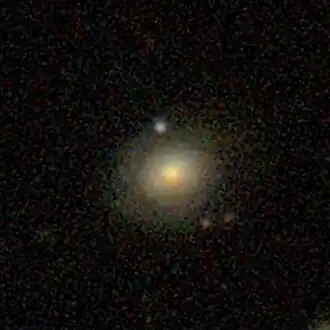NGC 5609
| NGC 5609 | |
|---|---|
 SDSS image of NGC 5609. | |
| Observation data (J2000 epoch) | |
| Constellation | Boötes |
| Right ascension | 14h 23m 48.3s[1] |
| Declination | 34° 50′ 34″[1] |
| Redshift | 0.100588 [1] |
| Heliocentric radial velocity | 30156 km/s[1] |
| Distance | 1.32682 Gly (407 Mpc)[1] |
| Apparent magnitude (V) | 15.7[2] |
| Apparent magnitude (B) | 16.5[2] |
| Characteristics | |
| Type | Sa? [3] |
| Size | ~175,230 ly (estimated) |
| Apparent size (V) | 0.38 x 0.31[1] |
| Other designations | |
| PGC 3088538[1] | |
NGC 5609 is a spiral galaxy[3] located 1.3 billion light-years light-years away from Earth,[4] in the constellation Boötes.[2] It has the largest redshift[5] of any galaxy in the New General Catalogue. Prior to 2023, another spiral galaxy, NGC 1262, had been thought to have a higher redshift.[6][5] NGC 5609 is the most distant visually observed galaxy in the NGC Catalog[5] and was discovered by astronomer Bindon Blood Stoney on March 1, 1851.[3]
See also
References
- ^ a b c d e f g "NASA/IPAC Extragalactic Database". Results for NGC 5609. Retrieved 2017-12-07.
- ^ a b c "Revised NGC Data for NGC 5609". spider.seds.org. Retrieved 2017-12-07.
- ^ a b c "New General Catalog Objects: NGC 5600 - 5649". cseligman.com. Retrieved 2017-12-07.
- ^ "Your NED Search Results". ned.ipac.caltech.edu. Retrieved 2017-12-07.
- ^ a b c Sky & Telescope Magazine, December 2023, pp 20
- ^ "Which NGC spiral has the highest redshift?". www.galaxyzooforum.org. Retrieved 2017-12-07.
External links
 Media related to NGC 5609 at Wikimedia Commons
Media related to NGC 5609 at Wikimedia Commons- NGC 5609 on WikiSky: DSS2, SDSS, GALEX, IRAS, Hydrogen α, X-Ray, Astrophoto, Sky Map, Articles and images